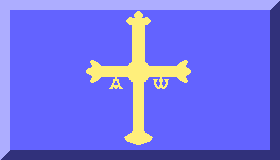

| |

The Asturian language is spoken in most of the Principality of Asturias (except in
the western strip beyond river Navia, where Galician is spoken), a land in the North of
the Iberian Peninsula. It belongs to the linguistic group, which is made up of several
dialects, although Asturian must be considered aseparate language, together with Mirandese
(co-official in Miranda del Douro, in the Portuguese Republic); both of these languages
may be seen as co-dialects, as it the case with Galician and Portuguese.
This old language derives directly from Latin and finds itself between Galician on the
left and Spanish on the right; however, this does not mean that it is simply a hybrid of
of these two languages. Rather,Asturian has a personality of this own that is well enough
defined to allow it to take its place amongst the Ibero-Romance languages.
The first texts written in Asturias can already be found in the Middle Ages, of
which"Fuero d'Avilés" is one the most important. Modern Asturian literature has
existed since the 16th century, at currently enjoys a healthy status. Nenetheless,
Asturian speakers have been moving away from their language over the last fifty yeaes due
to the presence of Spanish as the official language of the state and the only one which
was spoken in schools (even today the presence of Asturian in education is scarce). It is
from the cities and towns that the castilianization of the language is being carried
out,although social awareness of the inigenous language has been growing in recent years.
Thanks to thisnew-found awareness, young people now think of the language as a heritage
which has been left to them by their ancestors, a treasure which must be cared for. In
Asturias there is not a high number of immigrants from other parts of Spain,unlike in
Catalonia and the Basque Country,and this factor should help native Asturian in the
recovery of their language.
Unlike neighbouring communities, Asturias does not have its own television channel to
broadcast in Asturian. There are several radio programmes and even a weekly newspaper in
Asturian, but clearly these are not enough. The present day standard language was created
in 1981. The central dialect was taken as the basis for the unified language because it
was the main one in terms of the number of speakers and also for literature(most Asturian
literature was written in this dialect). However,contrubutions from the other dialects are
also permitted. Asturias has a very rich linguistic panorama. The two indigenous languages
of Asturias are Asturian and Galician in the region between the Eo and Navia rivers (that
why this area is called Eo-Navia Land). Asturian is divided into three main dialects:
Western Asturian, Central Asturian and Eastern Asturian. There has been a law in place
since 1998 for the protection of Asturian, but which fails to recognise its status as a
language. This is particularly worrying, as Asturian does not have the status of
co-official language in Asturias. Although its public use is permitted, there are no
guarantees of its future survival.
|